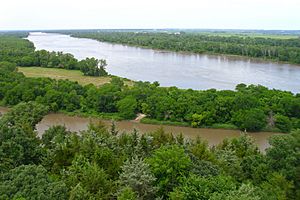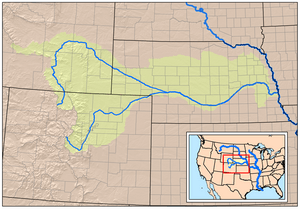Platte River facts for kids
Quick facts for kids Platte River |
|
|---|---|

Platte River at Mahoney State Park
|
|

Map showing the Platte River watershed, including the North Platte and South Platte tributaries
|
|
| Other name(s) | Nebraska River, Shallow River, Ñíbraxge (iow), Pȟaŋkéska Wakpá (lkt), Ní Btháska (oma), Kíckatus (paw) |
| Country | United States |
| State | Nebraska |
| Region | Great Plains |
| Cities | North Platte, Kearney, Grand Island, Fremont, Omaha |
| Physical characteristics | |
| Main source | North Platte River Confluence of Grizzly Creek and Little Grizzly Creek, Jackson County, Colorado 8,050 ft (2,450 m) 40°38′23″N 106°24′19″W / 40.63972°N 106.40528°W |
| 2nd source | South Platte River Confluence of Middle Fork and South Fork South Platte Rivers, Park County, Colorado 8,785 ft (2,678 m) 39°00′40″N 105°44′25″W / 39.01111°N 105.74028°W |
| River mouth | Missouri River Cass / Sarpy counties, at Plattsmouth, Nebraska 942 ft (287 m) 41°03′14″N 95°52′53″W / 41.05389°N 95.88139°W |
| Length | 310 mi (500 km), West-east |
| Basin features | |
| River system | Missouri River basin |
| Basin size | 84,910 sq mi (219,900 km2) |
| Tributaries |
|
The Platte River is a major river in the state of Nebraska and is about 310 mi (500 km) long. Measured to its farthest source via its tributary the North Platte River, it flows for over 1,050 miles (1,690 km). The Platte River is a tributary of the Missouri River, which itself is a tributary of the Mississippi River which flows to the Gulf of Mexico. The Platte over most of its length is a muddy, broad, shallow, meandering stream with a swampy bottom and many islands—a braided stream. These characteristics made it too difficult for canoe travel, and it was never used as a major navigation route by European-American trappers or explorers.
The Platte is one of the most significant tributary systems in the watershed of the Missouri, draining a large portion of the central Great Plains in Nebraska and the eastern Rocky Mountains in Colorado and Wyoming. The river valley played an important role in the westward expansion of the United States, providing the route for several major emigrant trails, including the Oregon, California, Mormon and Bozeman trails. The first Europeans to see the Platte were French explorers and fur trappers about 1714; they first called it the Nebraskier (Nebraska), a transliteration of the name given by the Otoe people, meaning "flat water". This expression is very close to the French words "rivière plate" ("flat river"), the probable origin of the name Platte River.
Images for kids
-
Platte River near Ft. Kearny State Historical Site in Central Nebraska
-
Encampment Along The Platte by Worthington Whittredge
-
Every year hundreds of thousands of sandhill cranes congregate on the Platte River during their spring migration, forming large flocks that use the sandbars of the Platte River as a nighttime refuge before dispersing to local fields to feed during the day.
-
A great blue heron and immature bald eagle on the Platte River in Nebraska
See also
 In Spanish: Río Platte para niños
In Spanish: Río Platte para niños






